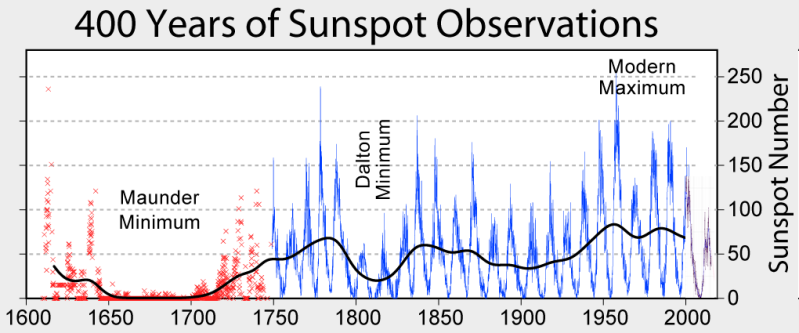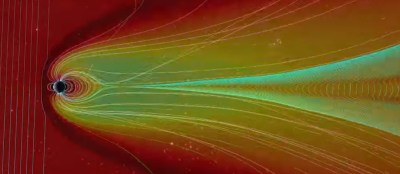
Most of us perceive time as an arrow, a one-way trip into the future. And while that’s true, nature has a way of interpolating circular patterns onto that linear model — day follows night, the seasons progress through the year, and generations are born, live, and die after creating the next generation to do experience the same cycles in the future.
Our star, too, follows this cyclical model, and goes through observable, periodic changes that are of keen interest to solar scientists. So it was with some fanfare that they recently announced that the sun had transitioned into Solar Cycle 25. But what exactly does that mean? Does the Sun’s changing face make much difference to the average person’s daily life? History shows that it can, so it pays to know what we’re in store for over the next couple of decades. Welcome to your primer on Solar Cycle 25.
It Goes to Eleven
For as long as scientists have had the ability to (safely) observe the Sun, they’ve noticed that our star is not the perfect glowing orb it at first appears to be. Galileo was among the first to observe that the Sun was marked by small dark imperfections. Observers began to keep track of these sunspots, noting not only their variable number but the fact that they migrate across the Sun’s surface with time.
It would take almost two and a half centuries for anyone to notice that the periodic nature of the patterns of sunspots. German scientist Samuel Heinrich Schwabe is credited with the discovery of the solar cycle in 1843 after 17 years of observations of the average number of sunspots. Swiss scientists Rudolf Wolf used the observations of Schwabe and others to backtrack through the data back to 1755. For solar science purposes, this was designated the year that Solar Cycle 1 started.

The cycle these pioneering solar scientists had discovered has a remarkably regular eleven-year period. The range of variation is very tight, from the nine-year period of Solar Cycle 2 (1766 to 1775) to almost fourteen years for Solar Cycle 4 (1784 to 1798). Each solar cycle is reckoned from a solar minimum, essentially when the sunspot number reaches its local low. The number of sunspots increases over the first half of the cycle, peaking at the solar maximum point before turning down again to head for the next solar minimum.
The raw number of sunspots is not the only interesting cycle the Sun displays. The distribution of sunspots across the Sun’s surface also changes periodically with the solar cycle. At the beginning of each solar cycle, what few sunspots there are tend to cluster at the Sun’s equator. As the cycle progresses and the Sun becomes more active, the sunspots tend to pop up further away from the equator, generally clustering around the mid-latitudes around 30° north and south. As solar maximum passes, sunspots again migrate back to the equator to start the cycle again.
Flipping Magnetic Poles
The periodic changes in the number and distribution of sunspots may be an interesting observation, but what does it mean here on Earth? To help understand that, it pays to recall that despite their dark appearance, sunspots are only marginally cooler than the surrounding solar material. Sunspots are still extremely energetic areas, and as the number of sunspots increases, the output of the Sun (in terms of luminosity) increases.
Sunspots represent places where concentrated lines of magnetic force emerge from deep within the Sun’s interior. Thus a change in the number and location of sunspots reveals changes in the magnetic field of the Sun. It turns out that what’s behind the solar cycle is these periodic changes in the Sun’s magnetic field. (It’s important to note here that the eleven-year cycle is technically the “sunspot cycle,” and the 22-year pole-flipping cycle is the true “solar cycle,” but it’s common practice to use “Solar Cycle” for both.)
The magnetic poles of the Sun are constantly in motion, with the north and south poles flipping every eleven years. At solar minimum, the magnetic poles are roughly aligned with the Sun’s orbital axis, and magnetic lines of force tend to penetrate the photosphere near the equator. As the poles rotate towards the equator, magnetic activity picks up, magnetic lines of force move to high latitudes, increasing the number of sunspots there. The process continues for the back half of the solar cycle as the poles complete their reversal.
So, as each solar cycle progresses due to the migration of the Sun’s magnetic field, solar output increases. Fractional though these changes are, they have obvious implications for life on Earth. But the increasing brightness of our Sun is far from the only impact felt here. The changing magnetic field of the Sun can also have a huge impact on our planet.
What Happens Next?
It’s well known that increased sunspots are associated with stronger and more frequent coronal mass ejections, or CMEs. These events, sometimes energetic in the extreme, occur when magnetic domains in the Sun become so twisted and contorted that they erupt outward, picking up gigatons of highly excited plasma from the Sun’s corona. If the CME occurs in just the right spot on the Sun’s surface, the violently ejected tangle of magnetic flux and plasma can strike the Earth, causing anything from an increase in auroral displays to the catastrophic destruction of infrastructure.
 While destructive CMEs are more likely to occur during solar maxima — the 1859 Carrington Event occured near the peak of Solar Cycle 10, and the 1989 Hydro-Québec disaster was about seven months before the peak of Solar Cycle 22 — it’s far from a rule that they only occur then. Plenty of damaging or potentially dangerous CMEs have occurred during solar minima. But the number of CMEs goes up dramatically with the sunspot number, so that the Sun launches a few large outbursts each day during a solar maximum. Simply increasing the number of shots increases the chances of a devasting strike.
While destructive CMEs are more likely to occur during solar maxima — the 1859 Carrington Event occured near the peak of Solar Cycle 10, and the 1989 Hydro-Québec disaster was about seven months before the peak of Solar Cycle 22 — it’s far from a rule that they only occur then. Plenty of damaging or potentially dangerous CMEs have occurred during solar minima. But the number of CMEs goes up dramatically with the sunspot number, so that the Sun launches a few large outbursts each day during a solar maximum. Simply increasing the number of shots increases the chances of a devasting strike.
While the increased risk of Earth-striking CMEs during solar maximum is a concern, it’s important to keep in mind a few things. First, solar maximum is still about five years away; NASA says that Solar Cycle 25 officially began in December of 2019, meaning we’re still very much in solar minimum conditions. Second, not all solar cycles are created equal. Layered on top of the eleven-year solar cycle are other periodic cycles that we’re only beginning to understand. One is the Gleissberg Cycle, an 87-ish-year cycle where the solar maxima of the eleven-year cycle tend to increase and decrease. We’re currently in the decreasing phase of the Gleissberg Cycle, meaning that the just-completed Solar Cycle 24 had a much lower solar maximum than the previous cycle. The current prediction is that Solar Cycle 25 will be about the same intensity as the previous cycle at solar maximum, and will reach solar maximum around July of 2025.

The potential for a sleepy sun for the next eleven years is a “good news, bad news” thing. On the plus side, there’s a greatly reduced — but far from zero — risk of experiencing a catastrophic Earth-striking CME. That means less risk to our vulnerable infrastructure, both terrestrial in terms of the millions of miles of power and communications wires we’ve stitched together, and space-based, since satellites can be greatly impacted by space weather. On the other hand, amateur radio operators and others who depend on ionospheric skip for long-range radio communications, like marine operators, airlines, and the military, always get grumpy when the sun is less active, since fewer sunspots mean decreased ionization of Earth’s atmosphere.
In the end, the Sun is going to do what it does, regardless of how it impacts life here on Earth. All we can do is learn everything possible about the star at the center of our solar system, build good models to predict its behavior over time, and build systems that can withstand our star’s mood swings.
